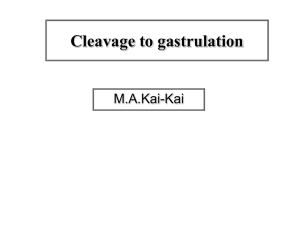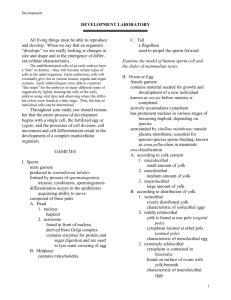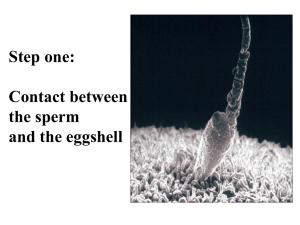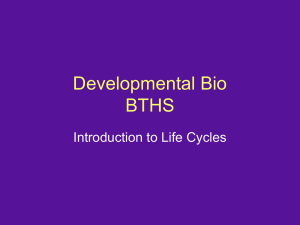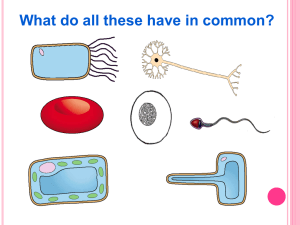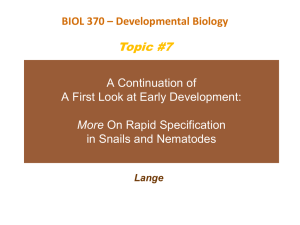chapter42_part1 - Lower Cape May Regional School District
advertisement
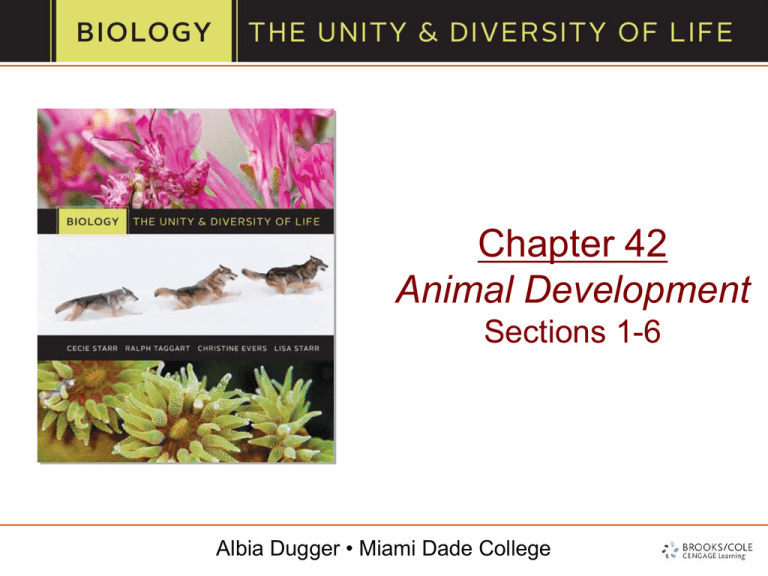
Chapter 42 Animal Development Sections 1-6 Albia Dugger • Miami Dade College 42.1 Mind-Boggling Births • In vitro fertilization (IVF) is an assisted reproductive technology which combines egg and sperm outside the body • Prior to IVF a woman is given hormones to encourage maturation of multiple eggs and to prevent natural ovulation • Each zygote undergoes mitotic divisions, forming a blastocyst that is placed in a woman’s womb to develop to term • Louise Brown, born in 1978, was the first “test tube baby” conceived by IVF Louise Brown with Husband and Son Nadya Suleman with IVF Octuplets 42.2 Stages of Reproduction and Development • Animals as different as sea stars and sea otters pass through the same stages in their developmental journey from a single, fertilized egg to a multicelled adult • In all sexually reproducing animals, a new individual begins life as a zygote, the diploid cell that forms at fertilization Sperm penetrates an egg, the egg and sperm nuclei fuse, and a zygote forms. Fertilization Mitotic cell divisions yield a ball of cells, a blastula. Each cell gets a different bit of the egg cytoplasm. Cleavage Cell rearrangements and migrations form a gastrula, an early embryo that has primary tissue layers. Gastrulation Organs form as the result of tissue interactions that cause cells to move, change shape, and commit suicide. Organs grow in size, take on mature form, and gradually assume specialized functions. Organ Formation Growth, Tissue Specialization Figure 42-2 p752 Processes of Development • Fertilization • Egg and sperm join to form a zygote • Cleavage (blastula formation) • Repeated mitotic divisions increase the number of cells (blastomeres), not the volume • Gastrulation • Gastrula (early embryo) forms with two or three germ layers (forerunners of tissues and organs) Processes of Development • Organ formation • The neural tube and notochord characteristic of all chordate embryos form early • Growth and tissue specialization • Many organs incorporate tissues derived from more than one germ layer • In some animals, a larva undergoes metamorphosis – a drastic remodeling of tissues into the adult form Three Primary Germ Layers • Outermost layer (ectoderm) gives rise to nervous tissue and to the outer layer of skin • Middle layer (mesoderm) gives rise to muscles, connective tissues, and the circulatory system. • Inner layer (endoderm) gives rise to the respiratory tract and gut linings Table 42-1 p752 Life Cycle: Leopard Frog gray crescent Figure 42-3b p753 blastocoel blastula Figure 42-3b p753 ectoderm dorsal lip future gut cavity yolk plug neural plate ectoderm mesoderm endoderm Figure 42-3b p753 neural tube notochord gut cavity Figure 42-3b p753 Figure 42-3b p753 Figure 42-3b p753 Figure 42-3b p753 ANIMATED FIGURE: Leopard frog life cycle To play movie you must be in Slide Show Mode PC Users: Please wait for content to load, then click to play Mac Users: CLICK HERE Take-Home Message: How does an adult vertebrate develop from a zygote? • A zygote undergoes cleavage, which increases the number of cells. Cleavage ends with formation of a blastula. • Rearrangement of blastula cells forms a three-layered gastrula. • After gastrulation, organs such as the nerve cord begin forming. • Continued growth and tissue specialization produce the adult body. ANIMATION: Early frog development To play movie you must be in Slide Show Mode PC Users: Please wait for content to load, then click to play Mac Users: CLICK HERE 42.3 From Zygote to Gastrula • Localization of yolk and other material in the egg cytoplasm and specific cleavage patterns affect early development • Cytoplasmic localization • Many cytoplasmic components in an unfertilized egg, are localized in specific parts of the cytoplasm • Hans Spemann showed that substances essential to amphibian development are localized in the gray crescent animal pole pigmented cortex yolk-rich cytoplasm vegetal pole sperm penetrating egg gray crescent fertilized egg Figure 42-4a p754 gray crescent of salamander zygote First cleavage plane; gray crescent split equally. The blastomeres are separated experimentally. Two normal larvae develop from the two blastomeres. Figure 42-4b p754 gray crescent of salamander zygote First cleavage plane; gray crescent missed entirely. The blastomeres are separated experimentally. A ball of undifferentiated cells forms. Only one normal larva develops. Figure 42-4c p754 ANIMATED FIGURE: Cytoplasmic localization To play movie you must be in Slide Show Mode PC Users: Please wait for content to load, then click to play Mac Users: CLICK HERE Cleavage –The Start of Multicellularity • Cleavage divides a fertilized egg into a number of small cells but does not increase its original volume • Cleavage puts different parts of the egg cytoplasm into different cells (blastomeres) which will make them behave differently later in development • Each species has a characteristic cleavage pattern Main Cleavage Patterns • Protostomes (bilateral invertebrates) undergo spiral cleavage • Most deuterostomes (echinoderms and vertebrates) undergo radial cleavage • Mammals undergo rotational cleavage Gastrulation • Starting with gastrulation, cells migrate about and rearrange themselves • Experiments by Hilde Mangold showed how gastrulation is regulated in vertebrates • Transplanted cells of the dorsal lip of the blastula (descended from the zygote’s gray crescent) induced gastrulation in salamanders Gastrulation in a Fruit Fly A Dorsal lip excised from donor embryo, grafted to novel site in another embryo. Figure 42-6a p755 B Graft induces a second site of inward migration. Figure 42-6b p755 C The embryo develops into a “double” larva, with two heads, two tails, and two bodies joined at the belly. Figure 42-6c p755 ANIMATED FIGURE: Embryonic induction To play movie you must be in Slide Show Mode PC Users: Please wait for content to load, then click to play Mac Users: CLICK HERE Take-Home Message: What are the effects of cytoplasmic localization and cleavage? • Enzymes, mRNAs, yolk, and other materials are localized in specific parts of the cytoplasm of unfertilized eggs. This cytoplasmic localization establishes polarity in the egg and thus influences early development. • Cleavage divides a fertilized egg into a number of small cells but does not increase its original volume. The cells— blastomeres—inherit different parcels of cytoplasm that make them behave differently, starting at gastrulation. 42.4 How Specialized Tissues and Organs Form • After gastrulation, cells become specialized as their movement and interaction begin to shape tissues and organs • Cell differentiation • Process by which cell lineages become specialized • Lays the groundwork for formation of specialized tissues and organs • Based on selective gene expression • Signaling molecules contribute to differentiation Responses to Morphogens • Morphogens • Signaling molecules encoded by master genes • Diffuse from a source and form a concentration gradient throughout the embryo • Have different effects depending on their concentration in each region A Morphogen • Bicoid protein of fruit flies is an example of a morphogen • The bicoid gene is a maternal effect gene expressed during egg production – its product influences development • Bicoid mRNA accumulates at one end of the egg—an example of cytoplasmic localization • A gradient of bicoid protein (a transcription factor) determines the front-to-back axis of the zygote Embryonic Induction • Gastrulation occurs when certain cells of the blastula make and release short-range signals that cause nearby cells to move about, either singly or as a cohesive group • By the process of embryonic induction, cells of one embryonic tissue alter the behavior of cells in an adjacent tissue • Example: Cells of a salamander gastrula’s dorsal lip induce adjacent cells to migrate inward and become mesoderm Organ Formation • After gastrulation, vertebrate organ formation begins with the neural tube • Neural tube development is induced by signals from the notochord, which formed earlier from mesoderm • Development begins when ectodermal cells overlying the notochord elongate, forming a thick neural plate neural plate (ectoderm) notochord (mesoderm) neural groove neural tube Figure 42-7 p756 ANIMATED FIGURE: Neural tube formation To play movie you must be in Slide Show Mode PC Users: Please wait for content to load, then click to play Mac Users: CLICK HERE Cell Migrations • Cell migrations are an essential part of development • Cells travel by inching along in an amoeba-like fashion • Actin microfilaments cause a portion of the cell to protrude forward, and adhesion proteins anchor it • Cells may move in response to a concentration gradient of some chemical signal or it may follow a “trail” of molecules that its adhesion proteins recognize How Cells Migrate Apoptosis • Programmed cell death (apoptosis) helps shape body parts • An internal or external signal sets reactions in motion that result in the activation of self-destructive enzymes • Example: Apoptosis eliminates the webbing between digits of a developing human hand Apoptosis Take-Home Message: What processes differentiate cells, tissues, and organs? • All cells in an embryo have the same genes, but they express different subsets of the genome. Selective gene expression is the basis of cell differentiation. It results in cell lineages with characteristic structures and functions. • Cytoplasmic localization results in concentration gradients of signaling proteins called morphogens. Morphogens activate sets of master genes, the products of which cause embryonic cells to form tissues and organs in specific places. • Migration, shape changes, and death of cells shape developing organs. 42.5 An Evolutionary View of Development • Similarities in developmental pathways among animals are evidence of common ancestry • Cytoplasmic localization in the egg induces expression of localized master genes • Concentration gradients of master gene products cause embryonic cells to form tissues and organs at certain locations A General Model for Animal Development • Where and when particular genes are expressed determines how an animal body develops • Positional information established by concentration gradients of master gene products affects expression of homeotic genes, which regulate development of specific body parts Developmental Constraints and Modifications • Physical constraints • Surface-to-volume ratio • Architectural constraints • Existing body frameworks, such as four limbs • Phylogenetic constraints • Master genes determine basic body form Lethal Murtations • Mutations that alter effects of master genes are often lethal • Example: Development of somites • Mesoderm on either side of the neural tube divides into blocks of cells that will develop into bones and muscles • A complex pathway involving many genes governs somite formation – any mutation that disrupts this pathway so that somites do not form is lethal during development Lethal Mutation Affecting Somites Take-Home Message: Why are developmental processes similar among animal groups? • In all animals, cytoplasmic localization affects expression of sets of master genes shared by most animal groups. The products of these genes cause embryonic cells to form tissues and organs at certain locations. • Once a developmental pathway evolves, drastic changes to genes that govern this pathway are generally lethal. 42.6 Overview of Human Development • Humans begin life as a single cell and go through a series of prenatal developmental stages • Second week: Blastocyst is embedded in the mother’s uterus, where it develops • Embryonic period (first 8 weeks): All organs form • Fetal period (9 weeks to birth): Organs grow and specialize • Postnatal growth (after birth): Organ growth and maturation continues through adolescence to adulthood Table 42-2 p759 Prenatal and Postnatal Changes 8-week embryo 12-week embryo newborn 2 years 5 years 13 years (puberty) 22 years Take-Home Message: How does human development proceed? • Humans are placental mammals, so offspring develop in the mother’s uterus. • By the end of the second week, the blastocyst is embedded in the uterus. • By the end of the eighth week, the embryo has all typical human organs. • Most of a pregnancy is taken up with the fetal period, during which organs grow and begin to function.

